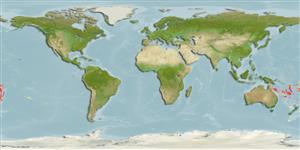>
Gadiformes (Cods) >
Macrouridae (Grenadiers or rattails)
Etymology: Hymenocephalus: Named for its transparent membrane-like head covering (‘‘hymen head’’) and fragile nature of head bones (Ref. 100825); megalops: From the Greek megas, great, and ops, eye, in reference to the notably large eyes of the species..
More on authors: Iwamoto & Merrett.
Environment: milieu / climate zone / depth range / distribution range
Ökologie
seewasser benthopelagisch; tiefenbereich 600 - 825 m (Ref. 35908). Deep-water
Western Central Pacific: known only from New Caledonia and off Queensland, Australia.
Size / Gewicht / Alter
Maturity: Lm ? range ? - ? cm
Max length : 17.0 cm TL Männchen/unbestimmt; (Ref. 35908)
Kurzbeschreibung
Morphologie | Morphometrie
Rückenflossenstacheln (insgesamt): 2. Gill rakers first arch (outer/inner) 12-19/20-24; barbel short 8-22% HL; orbits large 40-48%; snout usually 23-33%; orb.-preop. 36-7%; dorsolateral stripe on trunk fades out completely on tail.
A benthic species found on the continental slope (Ref. 75154).
Life cycle and mating behavior
Geschlechtsreife | Fortpflanzung | Ablaichen | Eier | Fecundity | Larven
Iwamoto, T. and N.R. Merrett, 1997. Pisces Gadiformes: Taxonomy of grenadiers of the New Caledonian region, southwest Pacific. Mem. Mus. Natl. Hist. Nat. (176):473-570. (Ref. 35908)
IUCN Rote Liste Status (Ref. 130435)
Bedrohung für Menschen
Harmless
Nutzung durch Menschen
Mehr Information
NamenSynonymeMetabolismusRäuberÖkotoxikologieFortpflanzungGeschlechtsreifeAblaichenSpawning aggregationFecundityEierEientwicklung
Alter/GrößeWachstumLänge-GewichtLänge-LängeLängenhäufigkeitenMorphometrieMorphologieLarvenLarven Pop.Dyn.RekrutierungDichteBRUVS
ReferenzenAquakulturAquakultur ProfilZuchtlinienGenetikElectrophoresesVererbbarkeitKrankheitenVerarbeitungNutrientsMass conversion
PartnerBilderStamps, Coins Misc.LauteCiguateraGeschwindigkeitSchwimmstilKiemenoberflächeOtolithsGehirngrößeSehfähigkeit
Tools
Zusatzinformationen
Download XML
Internet Quellen
Estimates based on models
Preferred temperature (Ref.
123201): 5.1 - 8.6, mean 6.7 °C (based on 59 cells).
Phylogenetic diversity index (Ref.
82804): PD
50 = 0.5000 [Uniqueness, from 0.5 = low to 2.0 = high].
Bayesian length-weight: a=0.00219 (0.00111 - 0.00431), b=3.20 (3.03 - 3.37), in cm total length, based on LWR estimates for this (Sub)family-body shape (Ref.
93245).
Trophic level (Ref.
69278): 3.3 ±0.4 se; based on size and trophs of closest relatives
Widerstandsfähigkeit (Ref.
120179): mittel, Verdopplung der Population dauert 1,4 - 4,4 Jahre. (Preliminary K or Fecundity.).
Fishing Vulnerability (Ref.
59153): Low vulnerability (10 of 100).
